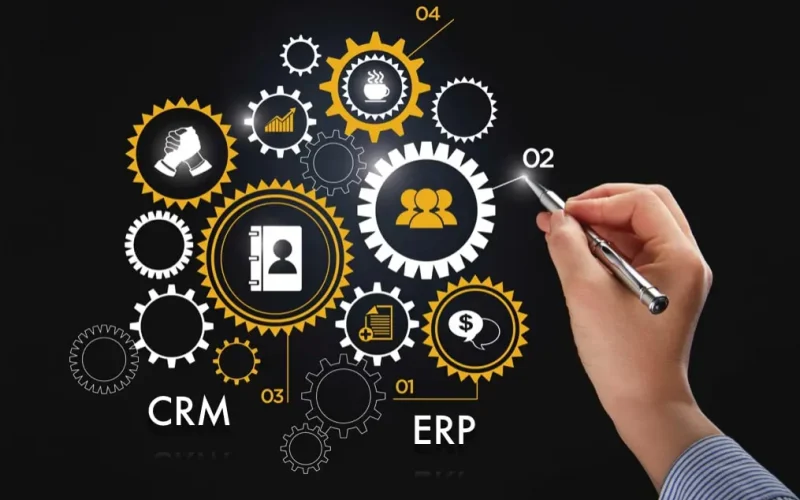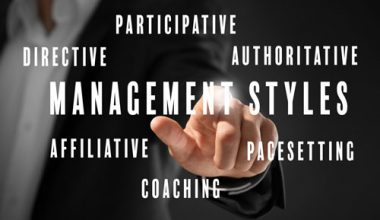Enterprise resource planning (ERP) and customer relationship management (CRM) are two key software solutions considered by businesses aiming to automate essential business activities. Some companies may need a CRM system in addition to ERP software. However, Enterprise resource planning (ERP) integrates a company’s financial and operational data into a single database, making it easier to administer, while customer relationship management (CRM) handles how customers interact with a company. They are equally important since they store data. Both involve several divisions and while they may share a common platform, they often use different pieces of software that are combined as needed. This article will help readers understand the major elements of CRM, SCM, and ERP integration, how they differ, and whether a given company needs both ERP and CRM.
So, it’s important that we define and understand ERP, CRM, and SCM before moving on.
What is ERP?
ERP (enterprise resource planning) software is comprehensive in that it may be used to handle a company’s finances, human resources, inventory, and distribution. The purpose of combining these procedures is to improve efficiency and consolidate data storage. Many systems are very customizable and allow the installation of additional modules and features to better fit each organization’s needs.
Also, Enterprise resource planning (ERP) solutions are often used by large corporations, but some small businesses have started to adopt them as well. In addition to facilitating better internal communication and data interchange, ERP software is notable for its front- and back-office information features. Because of the interdependence of several processes, automation is also an important component.
How Does ERP Software Work
In order to function, an ERP software or system adheres to a strict, standardized data structure. When data is entered into one division, it is immediately accessible to other authorized individuals in the company. Everyone can stay on the same page thanks to this consistent framework. Take the case of a regional food distributor with several branches that frequently share resources, such as inventory and employees. In addition, the ERP system or software is structured so that it is clear from where the quality, sales, and employee data has originated.
Then, the real-time information is integrated into the company’s workflows and procedures. Operations can ensure personnel levels are in line with traffic patterns, and management can see if one location is considerably better at avoiding spoilage than a sibling site a few cities over and attempt to figure out why. Finance can assist CEOs decide whether to combine by comparing sales to rents.
When a company has modules for all of its core business processes, and all of that data is entered promptly and correctly, that’s when the ERP system or software really shines. The more interested parties can access the data, the better.
It is feasible to integrate the various business systems used by a corporation to allow for the seamless transfer of data into the ERP system. Such up-to-the-moment information can subsequently be put to use in any number of ERP processes and workflows.
What Are the Functions of ERP?
Features can vary greatly depending on the provider you choose, but most of them share a few basics. The following are some characteristics you should seek out in a remedy.
#1. Financial Administration
Systems rely heavily on financial management and accounting software. In many organizations, they serve as the driving force behind operational efficiency. The approach is sustainable and meets financial constraints thanks to the available financial instruments. Accounts payable, receivable, general ledger and fixed asset management are all typical components. It’s possible that some software could aid in the creation of budgets, financial projections, and tax computations.
#2. Inventory Management
Automatic reordering and low-stock alerts are only two features that could be a part of a comprehensive inventory management system. In most cases, IM is only one part of a larger system that also includes distribution, warehouse, and/or manufacturing management. After all, you’ll have a clearer picture of the entire manufacturing process and more command over individual steps if you can track and manage inventory in addition to checking on the health of the equipment making your goods.
#3. Human Capital Management
One of the many uses for ERP software is in personnel management. Some of the functions of HCM software include paying workers, approving time off requests, and arranging work schedules. It’s possible that certain suppliers provide project management tools, letting clients keep track of which tasks have been assigned to which employees.
#4. Supply Chain Management
The suite of tools available in SCM software is extensive. One important part of this function is the management of purchase orders, distribution, quality monitoring, regulatory compliance, and manufacturing, in addition to IM. This area has a lot of space for innovation, and each provider has different ways to link and automate operations.
ERP Benefits
Enterprise resource planning (ERP) systems centralize the data of several administrative functions. Financial management, supply chain management, human resources, and other functions will all benefit from having a unified foundation upon which to make better-informed decisions. One way that ERP increases efficiency and productivity at work is by automating mundane, time-consuming tasks like data entry. In addition, ERP programs can:
#1. Saves Money
In order to save operating costs, ERP streamlines and centralizes many company activities inside a single platform. ERP systems reduce or do away with numerous administrative and operational expenses, such as redundant processes or data entry. Because of this, more may be accomplished in less time and with fewer resources, and employees will have more time to focus on creative endeavors that propel expansion. For instance, Blue Shield of California saved around $500,000 by moving to a cloud-based enterprise resource planning (ERP) system.
#2. Improve Productivity
When it comes to optimizing manual, repetitive operations that are prone to human mistakes, modern ERP systems incorporate process automation and artificial intelligence. By using ERP to automate finance and accounting operations, for instance, businesses can cut the time it takes to close the books by days, freeing up resources for more strategic endeavors. ERP is useful because it allows businesses to keep tabs on their inventory and customer orders in one centralized location. This enhances transparency and supply chain planning, which in turn aids in getting the proper products to clients on time.
#3. Facilitate Better Decision-Making
Users of an enterprise-level ERP system have access to granular data on financial and operational performance, as well as the ability to generate reports according to their specific needs and gain insight in real-time. It can speed up numerous activities by streamlining operations and reducing time spent searching for essential information. Together with automated processes and interconnected systems, this facilitates the rapid dissemination of reliable data to decision-makers, allowing for more agile responses to shifting market and economic situations.
#4. Foster Cooperation
Accounting, sales, logistics, human resources, and customers can all benefit from the centralized data and streamlined workflows made possible by enterprise resource planning (ERP) systems. Team members can take the initiative to find what they need without having to wait for someone else in the organization to find it for them in a siloed software system. Workforce planning, payroll, time and labor, procurement, and accounting are some of the areas where HR and finance collaborate. By accessing the same personnel data, both groups will be on the same page and less likely to make mistakes.
#5. Minimizes Risk
A reliable ERP system can support the maintenance of data integrity and the enforcement of financial rules. Having only authorized personnel with access to sensitive information improves audit trails and lessens financial and operational risk with the help of a centralized system and permission-based access.
What is CRM?
CRM stands for “customer relationship management,” which is an acronym. Systems like these are designed to increase customer satisfaction through a variety of channels, including more precise ad targeting and individualized sales conversations. Businesses use CRM software to improve customer experience in sales and marketing to increase revenue. After all, your business will not succeed unless it has loyal customers.
Both standalone and integrated versions of these tools into enterprise resource planning systems are on the market. In order to expand capabilities and encourage the development of unique solutions, some service providers permit customers to integrate external CRM systems with more pertinent or advantageous technology.
What Are the Functions of CRM?
The primary objective of customer relationship management (CRM) is to manage the customer’s experience as a lead, a prospect, and eventually a loyal customer. In order to accomplish this, most customer relationship management (CRM) programs will have the following characteristics.
#1. Contact Management
Using these apps, businesses can monitor and update their client data in real-time. However, using this function, you may pair up leads with certain reps and add them to multiple accounts. You may track the client’s participation in their company’s procurement activities. Contracts, invoices, and other customer-related paperwork can all be filed away in the application.
#2. Database Administration
Users from all throughout a company can access the same data in one convenient spot with the help of this useful technology. Some software packages provide data-cleaning tools for removing redundant or “dirty” information that could lead to erroneous conclusions. Downloading data from this resource and employing it in organizational procedures benefits prospective clients and intelligent analysis.
#3. Marketing and Campaign Management
Targeting consumers with specific ads is now fundamental to successful marketing campaigns. Users can now identify prospective campaign targets and evaluate the efficacy of their efforts with the help of this function. Some providers include interfaces with popular email clients, allowing users to effortlessly import contact lists and send marketing emails.
#4. Lead Management
You may get leads from several sources using this software, such as email, landing pages, and word of mouth. With the help of pipeline tracking, hierarchical connections, and territory management features, customers can determine how leads will be distributed and monitored. In addition, this feature also allows for the distribution of leads to diverse sales reps.
CRM Benefits
CRM systems allow businesses to develop and thrive by automating various customer-facing procedures, such as regular interactions with customers, marketing efforts, and the sales cycle. When a company implements customer relationship management, all departments are able to see the same, comprehensive picture of each customer’s interactions and interactions with the organization. Analyzing this data allows you to give clients more consistent, specific services and gain their trust, which boosts revenue. CRM systems, when used effectively, can:
#1. Boost Your Service to Clients
Consider your most recent experience with a company’s customer service department. How long did you have to wait? Were you transferred between different agents and forced to give the same information over and over again? By centralizing customer information, CRM helps build more precise profiles for each client, which in turn facilitates better communication and faster problem-solving across the sales, service, and marketing departments. These additions boost consumer happiness and, in turn, the likelihood that a one-time buyer will become a devoted supporter.
#2. Maximize Efficiency
Data entry and customer record updates, for example, are made much easier with the help of CRM software and automation. As a result, operations are sped up, errors reduce, and workers have more time to devote to tasks that truly matter. CRM systems automate and digitize many customer support interactions, which are accessible via email, live chat, chatbots, and social media. Also, live chat and similar tools expedite communication between customers and service agents. Artificial intelligence chatbots that utilize the company’s sales, service, and support knowledge base are available 24/7 to improve user experience. Email marketing is a great example of an outbound marketing channel that can benefit from AI-enhanced personalization and relevance.
#3. Extract Insights
Massive volumes of information on customers, such as their demographics, preferences, interactions with your firm, and purchase history, are generated and managed by customer relationship management systems. However, various facets of the business-to-customer interaction, such as invoicing and sales forecasting, can benefit from an examination of this data. Better products and services can be developed thanks to the information gleaned by research and development teams using this method. With the use of analytics, sales and marketing departments can give their customers the impression that they are being heard.
#4. Increase Your Sales and Client Retention
Sales may make better choices about how to best meet customers’ requirements and wants, as well as identify those customers who may be good prospects for upselling, when they have access to detailed information on these factors. Management of communications with customers and leads is facilitated by customer relationship management (CRM) systems, which provide a unified picture of all customer activity including interactions, transactions, contact information, and preferences. With this data, businesses may better understand their clientele and cater to their individual needs. Customer relationship management (CRM) systems keep tabs on every message, call, and other interaction that a company’s representatives have with a client, ensuring that the client’s information is always up to date and available.
What is SCM?
The term “supply chain management” refers to the coordination of all stages of a product’s life cycle, from the procurement of raw materials to the final delivery to the end user. A business develops a chain of suppliers (the “links”) to move its goods from raw material suppliers to consumer-facing companies.
Furthermore, an SCM facilitates the distribution of goods and services from their source through their final delivery. Supply chain management (SCM) helps businesses control how their goods and services move from their warehouses to their customers. In other words, SCM is at every step of the way, from the procurement of raw materials to the shipment of finished goods to the customer’s desired location. SCM is a one-stop shop for all supply chain actors, including raw material, component, and delivery providers.
Characteristics of Successful Supply Chain Management
In the eyes of clients and consumers, the supply chain is the “face” of the company. A company’s reputation and capacity to stay in business over the long term are safeguarded by its supply chain management. Here are the top characteristics.
- Connected: Having access to both social media’s unstructured data and the Internet of Things’ structured data, as well as the more conventional data sets made available by ERP and B2B integration technologies, is a huge advantage.
- Cyber-aware: Supply chain organizations should take precautions to prevent data breaches and other forms of cyber-intrusion seriously.
- Comprehensive: Analytics capabilities should scale with data in real time for optimal performance. There will be rapid and thorough insights. In the logistics network of the future, delays cannot occur.
- Collaborative: Increasingly, cloud-based commerce networks are being used to facilitate multi-enterprise collaboration and engagement, which improves collaboration with suppliers.
- Cognitively enabled: The AI platform coordinates and orchestrates choices and actions across the modern supply chain. The majority of the logistics network is now fully automated and self-teaching.
Significant efforts are being made to improve supply chain analytics, and many supply chains have already started this process.
SCM Benefits’
Low production costs, minimal scrap, and swift turnaround times are the results of efficient supply chain management. A just-in-time supply chain, in which rising demand at retail outlets triggers immediate production of more of the item in question, has become the norm. This allows for rapid replenishment of store shelves after each sale. One way to make this process more efficient is to analyze data from associated companies in the supply chain.
According to an analysis of partner data presented in a post on CIO.com, the following three situations highlight how efficient supply chain management may add value to the supply chain cycle:
#1. Detecting Potential Issues
Buyers have a right to complain about service quality when they place orders for more products than the supplier can fulfill. Manufacturers may be able to foresee the scarcity through data analysis and prevent the buyer’s disappointment.
#2. Adaptive Pricing Optimization
The shelf life of seasonal goods is short. These items are often discarded or sold at steep discounts once the season ends. Prices for airlines, hotels, and other services that offer time-sensitive “products” often fluctuate in real-time to reflect market conditions. However, similar margin improvement forecasting strategies employing analytic software can be used for even durable items.
What Is the Difference Between ERP and CRM?
The primary goal of enterprise resource planning (ERP) is to improve productivity by computerizing and standardizing all company-wide business procedures. Customer relationship management (CRM) focuses on external interactions and client retention, while enterprise resource planning (ERP) focuses on internal operations.
Departments including sales, marketing, and support use customer relationship management systems the most. Users of enterprise resource planning (ERP) software, on the other hand, are concerned with streamlining operational processes within their own organizations. Furthermore, while ERP seeks to enhance the precision and efficiency of the system, CRM is primarily concerned with expanding sales.
The primary functions of an ERP are those associated with managing workflow, including scheduling, invoicing, inventory, purchase orders, etc. On the other hand, a customer relationship management system focuses on managing and nurturing contacts and leads, as well as integrating social media and automating marketing.
ERP VS CRM Integration
Most companies that undertake a digital transformation do so in an effort to improve the efficiency of their core business operations and to increase their visibility into those processes. There are countless processes involved in running a business, but many of them form the bedrock of the organization. Therefore, it is crucial to have better oversight and management of such workflows than in the past.
ERP and CRM systems are two examples of useful software investments that can facilitate greater control and visibility. This is why ERP integration and CRM integration are so important to many IT workers, LOB managers, and execs.
Enterprise resource planning (ERP) software is designed to streamline and centralize data-driven business activities including order tracking, resource allocation, and project management. Businesses can streamline the management of their most important functions with the help of ERP software. Also, read ERP INTEGRATION: Meaning, Strategy, Software & System.
Furthermore, sales and marketing teams can greatly benefit from customer relationship management systems because of the ease with which data, purchases, and contacts can be managed. Companies use customer relationship management systems to learn more about their clientele and make educated choices about how to sell and communicate with them. Companies can also upsell and cross-sell their software and other solutions by better managing the ties inside their ecosystem.
What Are ERP and CRM Integration?
Integration of enterprise resource planning (ERP) software and customer relationship management (CRM) systems refers to the process of linking and syncing the two sets of software. The goal of ERP and CRM integration is to produce a single source of truth by ensuring that information is communicated between the two systems in a manner that is both automated and consistent.
What You Need to Know About CRM ERP Integration
Having a CRM ERP integration architecture that updates common information helps to standardize and automate your operations. There are a few recurring foci of overlap:
#1. Product, Quote, Price, and Inventory
The ERP is the central repository for product pricing, quotations, and stock levels. In order to provide offers to customers and verify product availability, sales professionals must access this data. In addition to keeping consumers updated on the status of their orders, your sales team will benefit from the seamless integration of product data with the CRM.
#2. Controlling Pricing and Orders
Although sales quotes usually come from the ERP system, salespeople prefer to use just the CRM and hence must have access to it. The ERP handles order management, invoicing, fulfillment, and shipping, whereas the CRM is used mostly for communication between the company and its customers. By syncing data between your CRM and ERP systems, you can ensure that your salespeople always have up-to-date quotes and orders.
#3. Access and Account
Information about leads and customers who have placed sales orders is stored in the CRM, whereas details about customers and accounts who have been charged, shipped, and paid for are stored in the ERP. Your account and contact details will always be up-to-date and redundant if you sync them.
#4. History of Sales Orders
Companies utilize artificial intelligence (AI) to analyze sales order data in order to make forecasts about customers’ likely future purchases. It is common practice for an ERP to store a company’s invoice booking history; thus, the ERP’s data must be linked with the CRM so that salespeople may access it.
CRM and ERP System Integration Best Practices
ERP and CRM connection can be difficult, but with the help of an iPaaS, the obstacles can be removed. Today’s iPaaS solutions are cloud-based and may be put to use in a variety of situations, including those involving the integration of applications, data, B2B ecosystems, on-premises integration, API publication, and more.
API integration platforms constitute the backbone of such systems since they facilitate connectivity, workflow design, data mapping and transformation, and an integration lifecycle. It’s typical for them to integrate with other business software like ERPs and CRMs.
High availability, disaster recovery, security, and other features necessary for corporations are supported by enterprise-class iPaaS platforms, which also allow firms to design and manage their own integrations in-house without requiring expensive expert services.
Comparison Between ERP and CRM Software
Here are the top 3 comparisons between ERP and CRM software.
#1. Data Analysis
By analyzing data to anticipate possible outcomes based on market and corporate conditions and performance, an ERP can assist businesses in taking proactive, strategic decisions. Whereas, a customer relationship management system can analyze data to provide patterns and expected outcomes, allowing businesses to take proactive and strategic approaches to manage the sales cycle, marketing campaigns, and customer satisfaction.
#2. Financial Management
When it comes to managing and anticipating a company’s revenue, expenses, and resource needs, ERP systems’ financial and accounting modules or integration possibilities can be invaluable. Although CRM software is not designed to handle a company’s financial management, many do provide useful tools for doing so, such as customer lifetime values (CLV) that anticipate a customer’s likely long-term value to the firm.
#3. Supply Chain Management Tools
An ERP software can improve supply chain management by automating repetitive tasks like resource planning and invoicing, and by centralizing operations in a single dashboard for better team coordination and visibility. A customer relationship management system can aid assisting supply chain managers in knowing what to store and when to stock it by tracking customer purchase histories, predicting customer lifetime values, and providing plausible scenarios of consumer demand. However, an ERP system provides more extensive assistance with resource planning than a CRM.
Do You Need Both CRM and ERP?
Whereas a customer relationship management system (CRM) increases sales and client relations, an enterprise resource planning (ERP) system helps simplify operations and reduces expenses. Combining an ERP with a CRM is a powerful way to expand a company’s operations.
Affordable SaaS solutions in the cloud today provide quick, automatic, and secure ERP and CRM integration. Also, to get the most out of your Enterprise Resource Planning (ERP) and customer relationship management (CRM) systems, you should implement full integration of the two.
Conclusion
Revenue optimization is facilitated by both CRM and ERP. However, their real functions are distinct; ERP is an all-encompassing solution that consolidates front and back office operations, whereas CRM focuses primarily on those three areas and their relationships. How extensive your needs are and how much money you are willing to pay to determine which program is suitable for your company.
ERP and CRM FAQs
Is Sap an Erp or CRM?
SAP ERP, or SAP Enterprise Resource Planning, is business software made by SAP SE. ERP, or enterprise resource planning, the software is modular software that unifies the fundamental operations of a company. So, SAP is an ERP.
Can an Erp Replace a CRM?
Both customer relationship management and enterprise resource planning system are essential to the success of any firm. Since they serve different purposes, you can’t switch one for the other. When used in tandem, the two methods can boost productivity and revenue. Thank goodness, there are a plethora of service providers who can
Why Is Erp Outdated?
Because they are not cloud-based, ERPs may soon become irrelevant. incompatibility with mobile devices. Having trouble adapting to the new program.
Similar Articles
- 5 Reasons Why ERP Software Is Important for Growth
- 2023 Best 15+ SMALL BUSINESS ERP SYSTEMS.
- RESOURCE PLANNING: Definition, Example, Types, enterprise & System
- ENTERPRISE RESOURCE PLANNING: (ERP) Examples, System, Function & Workday






